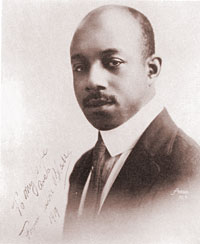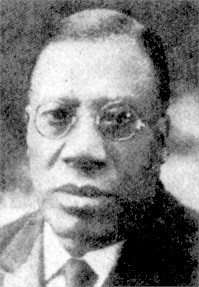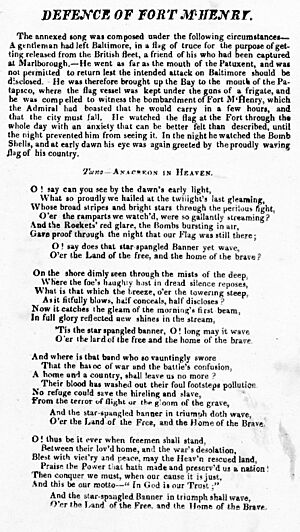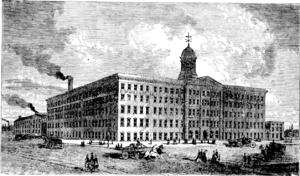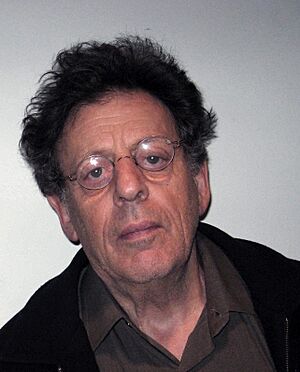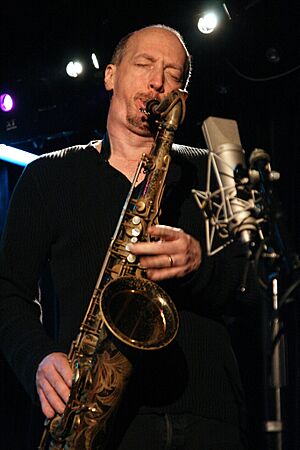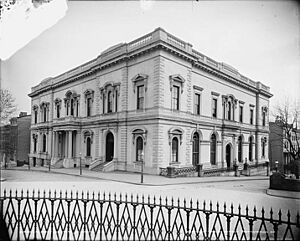Music of Baltimore facts for kids
The music of Baltimore, Maryland's biggest city, has a long history. It goes back to 1784. Baltimore has become a major center for classical music and jazz. Long ago, Baltimore was known for opera and musical theater. It was also important for music publishing and making musical instruments like pianos.
African American music has been a part of Baltimore since colonial times. By the 1860s, black musical life was very active. This included early ragtime and gospel music. Later, Baltimore jazz became famous, with many local musicians gaining national recognition. The city was a key stop for touring African American artists. Today, Baltimore is still a popular place for live music. It has also produced many modern rock, punk, and metal bands. There are also several indie labels for different music tastes.
Music education in Maryland follows state standards. The Baltimore City Public School System teaches music to all ages. Baltimore also has several colleges and universities with music programs. The Peabody Institute's Conservatory is a very famous music school. Other schools like Towson University also have big music programs. The Peabody Institute often hosts classical and chamber music performances. Baltimore is home to the Baltimore Opera and the Baltimore Symphony Orchestra. You can find many live music venues in areas like Fells Point and Federal Hill.
Contents
Music Through Time in Baltimore
The recorded history of music in Baltimore began in the 1780s. Before Baltimore was founded, not much is known about the music of the Native Americans living there. In the colonial era, opera and theater music were very popular. Protestant churches also played a big role in music. Baltimore grew as a trade center and became home to important music publishers.
In the 1800s, Baltimore's music scene grew a lot. It included a rich tradition of African American music. The city helped develop gospel music and jazz. Music schools like the Peabody Institute and groups like the Baltimore Symphony Orchestra became very important. Later in the 1900s, Baltimore became known for rock, R&B, and hip hop music.
Early Music: Colonial Times to 1800
Concerts were advertised in Baltimore newspapers as early as 1784. These concerts featured music by local composers like Alexander Reinagle and Raynor Taylor. They also played music by European composers such as Johann Sebastian Bach. Opera first came to Baltimore in 1752 with The Beggar's Opera. The first American performance of La Serva Padrona also happened here.
Baltimore's first theater was built by Thomas Wall and Adam Lindsay. This was despite a ban on theater by the Continental Congress in 1774. Maryland was the only state to allow theater during this time. The Maryland Company of Comedians performed plays, often adding songs. They sometimes had trouble finding musicians for their orchestra.
Formal singing schools started in Baltimore in 1789. These schools taught vocal skills for Christian psalmody. The first singing school was founded by Ishmael Spicer. One of his students was John Cole, who later became a famous music publisher.
Music Publishing Takes Off
The first music book published in Maryland was Baltimore Collection of Church Music in 1792. It had mostly hymns. In 1794, Joseph Carr opened a music shop in Baltimore. His sons, Thomas and Benjamin, had shops in other cities. The Carrs were very successful publishers. They published the first sheet music for "The Star-Spangled Banner" in 1814. Thomas Carr himself arranged the music. They also published European and American works. Their Musical Journal for the Piano Forte was the largest collection of secular music in the country.
In the late 1700s, American composers like William Billings created a new style of singing. John Cole, a Baltimore publisher, preferred European music. He published Beauties of Psalmody, which criticized the new American styles. Cole continued publishing music books until 1842. He also ran his own singing school. Other important Baltimore publishers included Wheeler Gillet and Samuel Dyer. Dyer collected more American-style songs. These music books often included instructions for learning music.
The 1800s: Growth and New Sounds
In the 1800s, Baltimore had a large African American population. This led to a lively black music scene, especially in Protestant churches. The city also had many music publishers and instrument makers. They specialized in pianos and woodwind instruments. Opera and classical music groups were also founded. Many of these groups became famous in the region.
The Holliday Street Theatre and Front Street Theatre hosted many shows. After the Civil War, new theaters opened. These included the Academy of Music and Ford's Grand Opera House. Ford's was very successful, hosting many opera companies. By the early 1900s, New York companies began to control the theater industry. Baltimore became a less common stop for touring shows.
African American Music Flourishes
In the 1800s, Maryland had many free African Americans. Baltimore was a hub for black culture and business. It was home to many black professionals and large black churches. These churches often helped people in need. In 1865, a big African American celebration happened in Baltimore. It marked the anniversary of the Emancipation Proclamation. Five years later, another celebration honored the right to vote for African Americans. Many bands, including brass bands, played at these events.
Baltimore's Eubie Blake, born in 1883, started playing music young. He developed a unique piano style using ragtime riffs. He wrote "The Charleston Rag" in 1899. Blake helped create the stride piano style. He played syncopated rhythms with his right hand and a steady beat with his left. He became one of the most successful ragtime players on the East Coast. He performed with famous entertainers like Mary Stafford.
Music in Black Churches
Black churches in Maryland were centers for music, politics, and education. Many African American musicians started in churches. These included Anne Brown, Marian Anderson, Ethel Ennis, and Cab Calloway. Church choirs often worked together, even across different denominations. Organists were very important in Baltimore's black church music. Some became well-known, like Sherman Smith and Julia Calloway. Many churches also offered music lessons.
Charles Albert Tindley, born in 1851, became a major composer of gospel music. This style mixed African American spirituals, Christian hymns, and folk music. Tindley's early music experience likely came from tarrying services. These were all-night prayer and singing events. He became a preacher and later opened a large church in Philadelphia.
More Music Publishers
Baltimore had a strong publishing tradition in the 1800s. This was helped by A. Hoen & Co., a big lithography company. They illustrated many music publications. Other important publishers included George Willig and Frederick Benteen. W. C. Peters was famous nationally. His company, W. C. Peters & Co., published the Baltimore Olio and Musical Gazette. This magazine had concert news, printed music, and articles.
Making Musical Instruments
Baltimore was also home to piano makers like William Knabe and Charles Steiff. Knabe started his company in 1837 and began making pianos in 1839. His company became one of the most respected piano makers in the country. It was very popular in the Southern states. After some challenges, Knabe's sons, Ernest and William, made the company successful again. Their pianos were so good that the Japanese government chose Knabe as its supplier for schools in 1879. Today, Knabe pianos are made by a Korean company called Samick.
Heinrich Christian Eisenbrandt moved to Baltimore in 1819. He made high-quality brass and woodwind instruments. He made flageolets, flutes, oboes, bassoons, and clarinets. He also made drums and basset-horns. Eisenbrandt received awards for his instruments. The Smithsonian Institution has one of his clarinets. His son continued the business after his death in 1861.
Classical Music Grows
The Peabody Orchestra, started in 1866, was Baltimore's first professional orchestra. It performed many new works. The Baltimore Symphony Orchestra was founded before 1890. It replaced the Peabody Orchestra.
Traveling opera companies often visited Baltimore. They performed famous operas like Norma and Faust. Famous singers like Jenny Lind performed here. Major opera companies from other cities also performed in Baltimore.
In the early 1800s, choral groups became popular. Many German immigrants helped these groups grow. They taught choral music and performed oratorios. These groups helped gain support for music education in public schools. Important groups included the Baltimore Oratorio Society and the Liederkranz.
Music Education Evolves
Singing schools became more common in Baltimore after the 1830s. Singing teachers started to include non-religious music. They also became independent from churches. Attendance grew a lot, especially after two important schools opened: the Academy (1834) and the Musical Institute (by John Hill Hewitt). These schools became rivals and had successful performances. Some teachers used new names for their programs, like the Glee School, which focused only on secular music.
Music was introduced into Baltimore public schools in 1843. This led to a decline in private singing lessons for youth. Publishers started offering music collections for schools. Adult music groups like the Haydn Society also grew after the Civil War.
The 1900s: New Sounds and Stars
In the early 1900s, Baltimore's most famous musicians were Eubie Blake and Noble Sissle. They became nationally famous in New York. Blake became a ragtime legend and helped create the stride piano style. Later, Baltimore became known for its lively jazz scene. It produced famous musicians like Paul Ugger. The Hammond B-3 organ became a key part of Baltimore jazz.
In the mid-1900s, Baltimore had important music media figures. Chuck Richards was a popular African American radio host. Buddy Deane hosted a popular TV show similar to American Bandstand. This show was a symbol of popular music in Baltimore. Doo-wop music also found an early home in Baltimore. More recently, Baltimore has produced many well-known rock, pop, R&B, punk, and hip hop artists.
Classical Music in the 20th Century
Many major music groups in Baltimore were founded by musicians trained at the Peabody Institute's Conservatory. These include Baltimore Choral Arts, Baltimore Opera Company (BOC), and the Baltimore Symphony Orchestra (BSO). These groups are highly respected and perform often. Baltimore has also produced famous modern classical composers. These include Philip Glass, a minimalist composer, and Christopher Rouse, who won a Pulitzer Prize. Glass grew up in the 1940s, working in his father's record store. There, he heard Baltimore jazz and rhythm and blues.
The Baltimore Opera Company started in 1950. It was led by the famous singer Rosa Ponselle. The company grew and became more professional. In 1976, they commissioned a new opera called Inês de Castro. Its debut was a big success for American opera.
The Baltimore Symphony Orchestra was reformed in 1916. It was the first orchestra in the country funded by a city. Gustav Strube conducted it until 1930. In 1942, it became a private group. Joseph Meyerhoff and Sergiu Comissiona helped make the BSO a top arts group in Maryland. Under David Zinman, the Orchestra recorded for major labels and toured internationally. They were the first orchestra to tour in the Soviet bloc.
The Baltimore Chamber Music Society, founded in 1950, is known for concerts featuring 20th-century composers. The Baltimore Women's String Symphony Orchestra existed from 1936 to 1940. At that time, women were not allowed in the Baltimore Symphony Orchestra.
In the early 1900s, Baltimore had several African American classical music groups. These were often documented by the Baltimore Afro-American newspaper. Charles L. Harris led the Baltimore Colored Chorus and Symphony Orchestra from 1929 to 1939. A. Jack Thomas was one of the first black bandleaders in the U.S. Army. He also directed the music department at Morgan College. Harris's band played marches and waltzes, and sometimes jazz-like music for dancing. However, jazz was not always accepted by the classical music establishment. The Peabody Institute even debated if jazz was "music" at all.
After World War II, the Peabody Institute began to integrate. It had previously denied entry to talented African American performers. In 1949, the Peabody officially ended segregation. The Baltimore Symphony Orchestra also became integrated. This process continued until 1966, when black and white musicians' unions merged. Baltimore is the hometown of African American classical opera tenor Steven Cole.
African American Popular Music
In the 1900s, Baltimore was important for ragtime music. It produced the legendary Eubie Blake. Later, Baltimore became a jazz hotspot. It was home to stars like Chick Webb and Billie Holiday. Baltimore's jazz scene started in the early 1900s. The city had a lively African American music tradition. This included funeral processions that started slow and ended with lively ragtime.
Pennsylvania Avenue (The Avenue) and Fremont Avenue were key areas for black musicians from the 1920s to the 1950s. Baltimore was a major stop on the black touring circuit. Jazz musicians often played on Pennsylvania Avenue. The street was known for its vibrant entertainment and nightlife. The most important venue was the Royal Theatre. It was one of the best African American theaters in the country. It was part of a famous touring circuit that included the Apollo Theater in New York. Audiences at the Royal Theater were known for being tough on performers who weren't good enough.
Music venues were segregated, but there was resistance. In 1910, a tour by Bert Williams led to a boycott of a segregated theater. Pennsylvania Avenue was also a center for black culture and business. It had many schools, theaters, and churches. Nightclubs like the Penn Hotel and the Sphinx Club were very important. The Sphinx Club, opened in 1946, was one of the first minority-owned nightclubs in the U.S.
The Baltimore Afro-American was a major African American newspaper in Baltimore. Radio personalities like Chuck Richards on WBAL were also important.
Eubie Blake and Noble Sissle
Baltimore's Eubie Blake was a leading ragtime musician in the early 1900s. He was known for his unique piano style, which led to the stride style. Blake helped make Baltimore a ragtime center. He performed in medicine shows and then moved to New York. Returning to Baltimore, Blake played in various venues.
In 1915, Blake met Noble Sissle, a singer. They formed a songwriting partnership. Their first song, "It's All Your Fault," was a hit. Their success grew quickly. They wrote many songs performed across the country, including on Broadway. In 1921, their musical Shuffle Along brought African American jazz and humor to Broadway. This show changed the theater industry. It created demand for black performers and led to integrated theater companies. When Shuffle Along came to Baltimore, Blake had trouble getting a seat for his mother because the theater was segregated.
Jazz in Baltimore
Baltimore had a local jazz scene by 1917. The Baltimore Afro-American noted its popularity. Jazz performers played on Baltimore Street, in an area called The Block. Audiences went to venues like the Richmond Market Armory and the Pythian Castle Hall. By the 1930s, The Ritz was the biggest club on Pennsylvania Avenue. It was home to Sammy Louis' band.
The first group in Baltimore to call themselves "jazz" was led by John Ridgely. They were known as the John Ridgely Jazzers. They played daily at the Maryland Theater in the 1920s. The most popular early jazz performers were Ernest Purviance and Joseph T. H. Rochester. They worked together as the Drexel Ragtime Syncopators.
The Royal Theatre was the most important jazz venue in Baltimore. Rivers Chambers led the Royal's band from 1930 to 1937. Chambers was a multi-instrumentalist who later formed the Rivers Chambers Orchestra. He was very popular with Maryland's high society. Tracy McCleary succeeded Chambers as bandleader at The Royal. His band, the Royal Men of Rhythm, included Charlie Parker at one point. Many Royal band members also played with touring acts. During World War II, some segregation rules relaxed. The Royal's band started hiring white musicians after the war. Chambers' orchestra became a fixture in Baltimore.
Baltimore's early jazz pioneers included Blanche Calloway, one of the first female jazz bandleaders. She was the sister of jazz legend Cab Calloway. Both Calloways, like many black musicians in Baltimore, studied at Frederick Douglass High School. Chick Webb, a famous jazz drummer, was also from Baltimore. Later jazz musicians from Baltimore include Elmer Snowden and Ethel Ennis.
After Pennsylvania Avenue declined in the 1950s, Baltimore's jazz scene changed. The Left Bank Jazz Society started weekly concerts in 1965. They featured big names like Duke Ellington and John Coltrane. Recordings from these concerts became legendary.
Baltimore is known for its jazz saxophonists. Recent performers include Antonio Hart and Ellery Eskelin. The city's jazz style mixes experimental northern jazz with a more emotional southern tradition. Famous early Baltimore saxophonists include Mickey Fields. Fields became a local legend, refusing to perform outside the region.
In the 1960s, the Hammond B-3 organ became important in Baltimore jazz. Jimmy Smith was a virtuoso on this instrument. The Left Bank Jazz Society continued to promote jazz. However, jazz's popularity declined by the early 2000s. Still, the city continued to produce local performers.
Doo Wop Music
Baltimore had a big doo wop scene in the mid-1900s. It started with The Orioles, one of the first doo wop groups to record. By the 1950s, many African American vocal groups were in Baltimore. Talent scouts looked for new stars. Bands like The Cardinals and The Plants emerged. Some doo wop groups were linked to street gangs. Music and dance competitions were part of black street gang culture. This led to rivalries among performers.
The Orioles developed the city's vocal harmony sound. They were first called The Vibra-Naires. Led by Sonny Til, they recorded "It's Too Soon to Know". This song is considered the first doo wop recording. Doo wop greatly influenced rock and roll. The Orioles are seen as one of the earliest rock and roll bands. They continued recording hits like "Crying in the Chapel" until 1954.
Soul Music
Baltimore is not as famous for soul music as cities like Philadelphia. However, it had several soul record labels in the 1960s and 1970s. One was Ru-Jac, which started in 1963. Its artists included Joe Quarterman and Arthur Conley. Soul music venues included The Royal and Carr's beach in Annapolis.
Punk, Rock, Metal, and Today's Scene
Some famous musicians are from the Baltimore area. These include Ric Ocasek (The Cars) and David Byrne (Talking Heads). Others are Frank Zappa, Tori Amos, Cass Elliot (The Mamas & the Papas), and Adam Duritz (Counting Crows vocalist).
Notable Baltimore-area rock bands from the 1970s and 1980s include Crack The Sky, The Ravyns, and Kix. Tony Sciuto, an Epic recording artist, also grew up in Baltimore. He was a member of Little River Band and Player. He has written songs for Tina Turner and Don Johnson.
Baltimore's hardcore punk scene was smaller than Washington, D.C.'s. But it had local bands like Law & Order and Fear of God. Many bands played at places like the Marble Bar and Jules' Loft. The 1980s also saw a local new wave scene. Later, emo bands like Reptile House had some success.
By the late 1990s, bands like Lungfish became regionally prominent. More recently, Baltimore's music scene has produced artists like Animal Collective, Spank Rock, Beach House, Future Islands, and Dan Deacon. Many of these artists are part of the New Weird America movement.
In 2009, Baltimore got its own rock opera company. The all-volunteer Baltimore Rock Opera Society creates original rock operas.
Music Venues in Baltimore
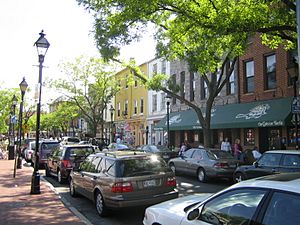
Many of Baltimore's nightclubs and music venues are in Fells Point and Federal Hill. Some famous ones include Cat's Eye Pub and the Sportsmen's Lounge. The Sportsmen's Lounge was a major jazz venue in the 1960s.
Many legendary music venues in Baltimore have closed. Most of the places on Pennsylvania Avenue, the center of the jazz scene, are gone. The Royal Theater, once a top spot for African American performers, was torn down in 1971. Only a plaque marks its spot. However, a statue of Billie Holiday remains on Pennsylvania Avenue. It has a quote from her: I don't think I'm singing. I feel like I am playing a horn. I try to improvise. What comes out is what I feel.
Baltimore has six major concert halls. The Lyric Opera House looks like the Concertgebouw in Amsterdam. It reopened in 1982. The Joseph Meyerhoff Symphony Hall also opened in 1982. It is the permanent home for the Baltimore Symphony Orchestra. The Joseph and Rebecca Meyerhoff Auditorium at the Baltimore Museum of Art also hosts concerts. Johns Hopkins University's Shriver Hall and the Peabody's Miriam A. Friedberg are also important venues. The Friedberg is the oldest still in use.
Music Education in Baltimore
In Baltimore's public schools, music education is part of every grade level up to high school. After that, it becomes optional. Starting in first grade (around age six), students learn about melody, harmony, and rhythm. They learn to echo short musical patterns. They also learn about different musical instruments and types of songs. As students get older, they learn more detailed techniques. For example, second graders perform rounds. Dance is added in third grade. In middle school (sixth grade), students learn to understand and respond to different music forms. In high school, students can choose music classes like instrumentation or singing. Music may also be part of theater or drama classes.
Public school music instruction in Baltimore began in 1843. Before that, professional singing masters taught music. Music groups like the Baltimore Symphony Orchestra sometimes have programs for young people. The Eubie Blake Center promotes African American culture and music. It offers dance classes, workshops, and seminars for all ages.
Higher Education in Music
Baltimore's most famous music school is the Peabody Institute's Conservatory of Music. It was founded in 1857, with classes starting in 1868. George Peabody provided the money for the school. In 1977, the Conservatory joined Johns Hopkins University.
Other colleges in the Baltimore area also offer music education. These include Towson University, Goucher College, and Morgan State University. They all teach music and host concerts. Bowie State University offers music and music technology programs.
The Arthur Friedham Library collects historical music documents from Baltimore. The Peabody and the Maryland Historical Society also have archives. Johns Hopkins University's Milton S. Eisenhower Library has the Lester S. Levy Collection. This is a very important collection of American sheet music. It has over 40,000 pieces, including original printings of songs like "A Perfect Day".


